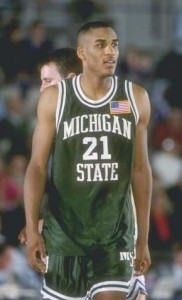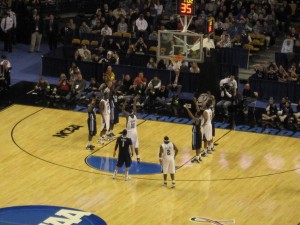
Past Imperfect is a series focusing on the history of the game. Each week, RTC contributor JL Weill (@AgonicaBoss| Email) highlights some piece of historical arcana that may (or may not) be relevant to today’s college basketball landscape. This week: the greatest Sweet 16 and Elite Eight ever, the 1990 NCAA Tournament.
By the time the 1990 NCAA Tournament hit its second weekend, fans had already been treated to quite a show: 16th-seeded Murray State pushing top seed Michigan State to the wire; Loyola Marymount’s emotional return to the court following the tragic passing of All-American teammate Hank Gathers and stunning rout of defending champion Michigan; upsets by Ball State, Dayton and Northern Iowa; surprise takedowns of high seeds Kansas, Purdue and No. 1 Oklahoma.
But as much as the results, 1990 in many ways represented a modern apogee for college basketball – a natural peak that was a nexus of upperclassman experience, elite talent and athleticism and a growing American obsession with this quirky college tournament cum mega-event. As television numbers soared and a new generation of basketball fans came of age, interest in the NCAA Tournament was at an all-time high, and the product on the court was worthy of it.
Basketball is a game that has weathered changes in style, scandals of all levels and cycles of roster attrition, any of which might have crippled a less beloved sport. But while there have always been flaws, much of the negativity and cynicism that has since widened the gap between fans of the college game and fans of the modern NBA at the end of the 1980s had yet to be amplified by the combination of youthful revolt, unmitigated marketing and an ever-present media lens that we accept as the norm today. Likewise, at the time the 1990 tourney tipped, ESPN had yet to dominate the sports broadcast market the way it does now and, while viewership of cable television was certainly widespread, Americans were still mostly attuned to a tradition of watching major sporting events like the NCAA Tournament on network, and even more so, local television. And, certainly not to be ignored, this was long before the Internet changed forever the way fans consumed, discussed and dissected the sports the watched.

- NBA talents with years of college experience like Michigan State’s Steve Smith made the 1990 NCAA special.
But if in these many ways the beginning of the 1990s was a more innocent time for fans, it was a more experienced and developed time for college basketball. Since Magic Johnson had been drafted No. 1 overall as a sophomore in the 1979 NBA Draft, only 12 underclassmen had been selected in the draft to that point, and of those, none had been freshmen from Division I colleges. There was a fundamental agreement that freshmen were not physically ready to play with grown men in the NBA, and despite the Spencer Haywood decision of the early 1970s granting high school players the right to be drafted, only three high school players had opted to skip college entirely: Moses Malone, Darryl Dawkins and Bill Willoughby.
The result was that coaches continued to build teams around star players who they knew were not only talented, but also would be around long enough to accrue the experience that came with having played at least two years in college already. Any fan of college basketball knows that while added playing experience is certainly no guarantee of success at the college level, it sure does help.
So came the 1990 tournament, flush with future pros, plus Hall of Fame and soon-to-be-household-name up-and-comer coaches, too. There were blueblood programs and upstarts alike. And the opening weekend of the tournament was a fantastic one. But if the first two rounds had produced great games and standout individual performances, it was only a prelude to the grand waltz of the weekend ahead. From March 22-25, 1990, college basketball showed, on its grandest stage, all of the best things its season-ending tournament had to offer: emotion, drama, intrigue, and controversy – not to mention collegiate athletics played at the highest level.
It all began with a bang. Two years before a miracle full-court pass and shot at the Meadowlands in East Rutherford, N.J., would become one of the most replayed and remembered moments in NCAA Tournament history, another, different but equally improbable full-court catch and shoot would captivate college basketball fans’ imaginations … for all of two days.
Few people remember now that when coach Jim Calhoun took over the University of Connecticut program it was arguably the worst in Division I. Now, in just his fourth year, Calhoun had the Huskies as the East Region’s No. 1 seed, facing a talented fifth-seeded Clemson in the Sweet 16. Strong and oozing confidence, UConn opened a 19-point lead. But in the second half, Clemson went on a 25-8 run to cut the lead to two with just over three-and-a-half minutes left. With only 12 seconds remaining in the game, Clemson sophomore David Young hit a three-pointer to give the Tigers their first lead since early in the first half. UConn point guard Tate George missed a jump shot with four seconds left, Clemson rebounded and was fouled. But after forward Sean Tyson missed the free throw, UConn collected the rebound and called time out. One second remained on the game clock.
Read the rest of this entry »














































